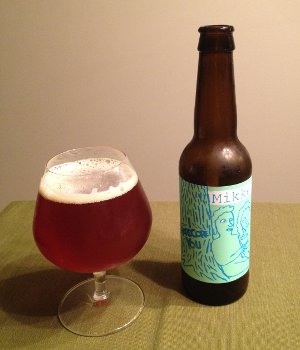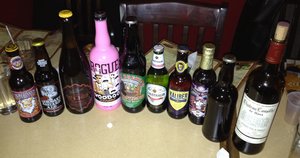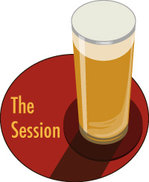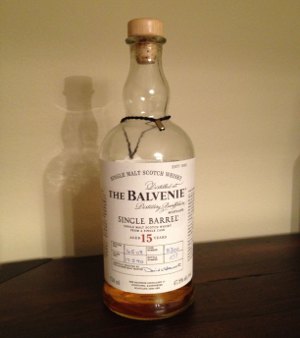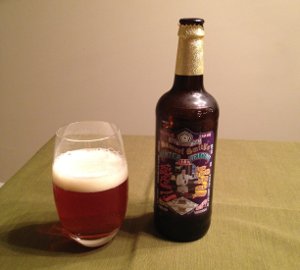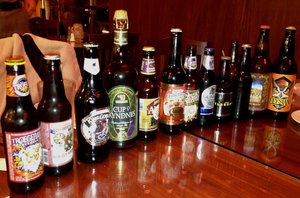Tonight was beer club, a meeting of beer minded individuals from my work who get together for a meal and lots-o-beer once a month. As usual, a core group of stalwarts showed up, along with some new faces and other return guest stars. All told, a solid turnout, plenty of good beer, and a fun time had by all.
(Click for bigger image)
Apologies for the image quality. Brightness kinda got away from me there. Stupid flash. For the sake of posterity, some thoughts on each beer we tried are below. Standard disclaimers apply, though I think I’ve achieved a new level in beer nerdom in that I’ve already had (and probably reviewed) a lot of the beers presented here. Go figure. Roughly (yeah, yeah, gimme a break, it’s a social gathering after all, you’re lucky I can do this much) listed in order of drinking, not the order in the picture above:
- Hitachino Nest White Ale – This has actually been on my radar for a while, but it’s not something I’ve ever tried before. It’s a very solid Belgian wit beer, not super strong on the wheat (though it’s there), more defined by the Belgian yeast character of fruit and dry spice. Sorta reminded me of St. Bernardus’ Tokyo beer, which is not suspicious at all, as Hitachino is Japanese (I swears, I didn’t realize it when I was drinking, except perhaps subconsciously because Hitachino does sound pretty Japanese). Really worth checking out, and it won’t break the bank like St. Bernardus will. A-
- Innis & Gunn Oak Aged Beer – This must be the 4th or 5th time I’ve had this. I’ve always enjoyed it too, though I didn’t have any sticky toffee dessert dish to pair it with (like I normally do). A solid contribution from a beer club newcomer. B+
- Ballast Point Sculpin IPA – Yep, another that I’ve had several times before, but I do love this beer. It seems that some beer club members have been doing some research on Beer Advocate and this is a pretty good choice. Well played, Paul. A-
- Magic Hat Hi.P.A. – A decent enough IPA that I think just pales (pun intended!) in comparison with Sculpin. Flavors seemed muted and a little bland, but seemingly well crafted enough. Not something I’d seek out again, but I wouldn’t turn it down if you handed me one. B-
- Kaedrin Abbey Dubbel Xmas – A variant on my homebrewed abbey dubbel beer, when I was bottling and I got to the bottom of the bucket I added a cinnamon stick and some clove to the remaining beer. Alas, I didn’t get much additional spice out of this, at least in my small sample. However, I feel like the beer has finally conditioned into something solid. Still not quite what I was going for, I think perhaps too much in the Special B department, yielding a bit too much in the way of toasted malt character, but still, it’s coming along well. I will refrain from rating this for now, as I don’t think it’s peaked yet, but perhaps a full review will be forthcoming.
- Anchor Our Special Ale 2012 (Christmas Ale) – Just reviewed this one yesterday (along with the 2011 variety). This was one of my contributions, so of course it was good.
- Evolution Secret Spot Winter Ale – I’ve enjoyed most of Evolutions offerings that I’ve tried so far, and this one is no exception. But it’s not really exceptional either. Another beer that may have suffered a bit by comparison to the previous beer. Technically an altbier, this drinks kinda like a winter warmer without the spice. I like. Want to try again in better context. B
- Lagunitas Brown Shugga’ – Yep, just reviewed this one too. Big flavors do well in beer club setting.
- Mikkeller Santa’s Little Helper 2011 – One of my contributions… I’ve had the 2010 vintage, and though Mikkel claims to tweak the recipe every year, this seemed pretty similar to me. It’s listed as a Belgian Strong Dark, but it reads more like an Imperial Stout. Lots of chocolate and roasted malts, smooth, well hidden booze. It’s said that this is a spiced beer, but it’s hard to detect in this. Definitely a complex beer, and I’m guessing the spices contribute to that without being overpowering. Overall, a very good beer, worthy of the holiday. A-
Ommegang Scythe & Sickle – Malt-focused, Belgian-style harvest ale, recently reviewed! Well chosen and well placed in the tasting. This works well with food (which came out as I was drinking this)… B+
So there you have it. Another successful beer club. Good company, good food, good beer. As always, already looking forward to the next installment.


